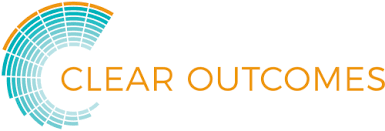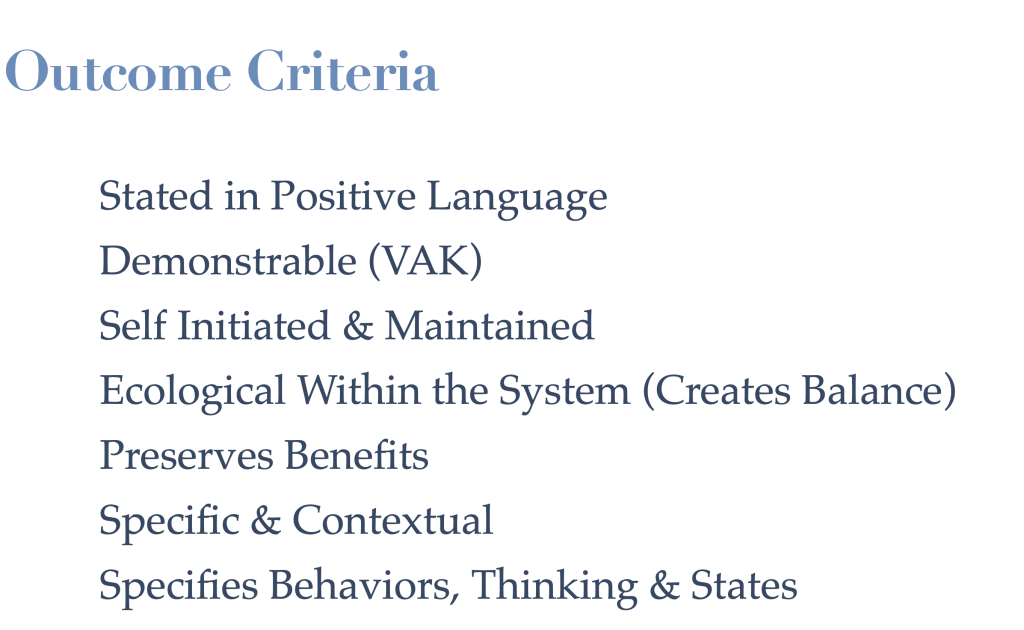MindBridge NLP Coach Certification Training
-
1 - Introduction to Professional Life Coaching and NLP8 Topics
-
Managers as Coaches
-
2 - Fundamentals of Influential Communication5 Topics
-
3 - a. Characteristics of Excellence in Communication2 Topics
-
3 - b. Submodalities
-
4 - a. Identifying Thinking Styles1 Topic|1 Quiz
-
4 - b. Rapport
-
5 - a. Values Clarification
-
6 - a. Anchoring Techniques2 Topics
-
7 - Clarifying Communication5 Topics
-
7 - a. Power of Questions
-
7 - b. Intake- Initial Pre-Coach Session
-
8 - Criteria3 Topics
-
8 - a. Perceptual Flexibility - Perceptual Position Quiz3 Topics
-
8 - b. Well-Formed Outcomes3 Topics
-
9 - 3 NLP Techniques Demonstrations
-
10 - Identifying Mind Maps
-
10- a. Meta Program Psychometric Quizzes
-
10 - b. Key Meta Program Patterns Explained7 Topics
-
10 - c. NLP Coach Session Demonstration
-
10 - d. Evaluation Forms -Outcome Coach Session
-
10 - e. Evaluation Video of NLP Coaching Demonstration
-
11 - NLP Coaching Sessions2 Topics
-
11 - a. Evaluation of Demo - Categories of Experience
-
11 - b. Directionalizing the Session
-
12 - Insights and Just for the fun of it!

Outcomes
A well-formed outcome is like a financial plan. It sets the frame for the allocation of resources with feedback from the market as to appropriate adjustments. The level of attention given to creating the outcome has a direct bearing on the performance with which desired results are achieved.
A well-formed outcome makes the difference between getting stuck and overwhelmed with the daily details of work (running on automatic and sometimes in circles) and precision execution of critical tasks in the most time efficient and appropriate manner.
A well-formed outcome describes the designated task(s), in sensory based, positive terms. It includes a description of what the task is, and the terms, conditions and environment—when, where and with whom the task is executed. It requires reflection of different approaches to the outcome, time frames, costs and consequences to the parties involved, and whether it is within control of the person or team performing the task(s).
One of the criteria of a well-formed outcome is that it includes consideration of the result it is meant to produce; the purpose or broader perspective of the desired state. This determines whether the underlying criteria is being met.
Since the question ‘why’ directs attention to the past in the context of a desired future, backward directed attention has limited use. The question ‘how’ provides more immediate usefulness in direction attention toward the desired outcome. To find the intended purpose of a course of action, we need to ask what the action is for. These answers are more likely to elicit responses beginning with phrases like ‘to make…’ or ‘to provide…’ or ‘to do….’ They contain an element of action, of purpose, of forward momentum and direction. Intent is presupposed, and information is brought into the system to facilitate action.
Setting the conditions of a well-formed outcome presupposes evidence, and evidence must be sensory based — which means something that another person could see, hear or feel, if it were pointed out to them. Abstract ideas and concepts can easily be described in sensory-based terms. Because we respond to our thoughts and images with behavior, responses are visible to observers. If someone said they wanted ‘satisfaction of a job well done’, the question becomes what would someone else see, hear or feel that would let them know that the individual was in fact experiencing satisfaction. The answer would describe the person’s behavioral demonstration of ‘satisfaction’.
The question of who is in control, and of other’s involvement, draws the focus to what might need to be done before the main project can happen. If an outcome depends on team involvement, then you in fact have parallel outcomes nested within a larger outcome frame.
In reference to a business project, during the process of working out the primary goal or outcome, component parts are subject to preparation on their own account to make the whole project possible. Chunking or breaking a larger outcome into separate outcomes which are also specified and sensory-based facilitates completion with efficiency of time and resources. This makes the well-formed outcome a valuable project management tool, as it addresses the question of acceptability of costs and consequences.
In the frame of a well-formed outcome, ecology is the word used to identify whether the outcome has acceptable costs, time frame, and consequences including benefits.
There are two parts to this question: 1. Is the outcome worth the effort, time and other costs involved in getting there, including constraints and inconvenience on valued third parties?; and 2. Is the end result worth having and keeping? Does it support or detract from the chosen work/life style, relationships, and other factors that matter? Does the time frame fit? Are all the necessary resources (skills, land, labor, capital, creativity, networks, relationships) available to bring the project into the chosen time and cost scale?
Another Look at Outcome Considerations

Stated in Positive Language: What do I want?
This question is about the context the client is considering. “What do you want? Where do you want it? When do you want it?” E.g: “I want to be, do or have X.” If the answer forms as “I do not want…”, then ask “What do you want instead of …’”
Feasibility: Is it achievable?
Is it possible for a human being to achieve the outcome? If it has been done by someone, then in theory it can be done by others. If you are the first, find out if it is possible.
What evidence will the client accept that lets them know when they have the outcome? Ensure that the evidence criteria are described in sensory based terms; i.e., that which can be seen, heard and/or touched that proves to you and/or others that you have done what you set out to accomplish.
Evidence: What will I accept as evidence that I have achieved my outcome?
Manageable – Self Initiated & Maintained: Is achieving this outcome within my control?
Is it under your control, can you, personally do, authorize or arrange it? Anything outside your control is not ‘well-formed’. Instructing your staff is within your control. So is buying expertise. Asking your employer for time off is not. The asking is within your control, but getting the time off will only become well-formed if it is granted.
Preserves Benefits: Are the costs and consequences of obtaining this outcome acceptable?
Ensure that the outcome is worth the time, outlay and effort involved in achieving it, and that impact on third parties or the environment is accounted for.
Resources: What are the resources needed?
Do you have or can you obtain all the resources, both tangible and intangible, that you need to achieve your outcome? Resources include knowledge, beliefs, objects, people, money, and time.
Ecological: What is it going to take to bring this about? What potential effects might it have on others and on the system of which it is a part?
Are all costs and consequences of achieving your outcome, including the time involved, acceptable to you and anyone else that could be affected by it? This is known as ecology. Consider the costs, consequences, environmental and third party impact of having the outcome

Responses